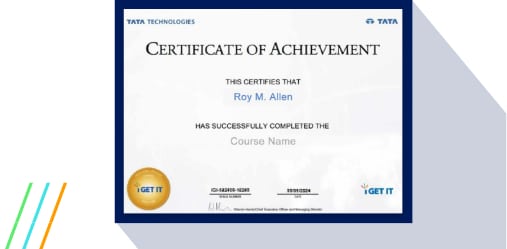EV – Battery Management System BMS
December 19, 2024 2025-01-06 11:27EV – Battery Management System BMS
EV - Battery Management System BMS
A complete guide to designing, implementing, and maintaining BMS for next-gen vehicles.
About the EV - Battery Management System BMS Training
This course dives deep into the principles, components, and operations of Battery Management Systems (BMS) used in electric and hybrid electric vehicles. With a focus on both theoretical and practical learning, it covers everything from the fundamentals of battery technology to the latest advancements in BMS design and applications.
Learning Experience
EV - Battery Management System BMS Training Highlights
Comprehensive training to master the art of BMS design and operation for EVs.
Covering all aspects of BMS
Of in-depth learning
Including SAE J1715
Featuring Ather 2W and TATA Tiago 4W systems
From industry experts
At the end of the course, you’ll be able to
- Understand the core functions and specifications of a BMS.
- Analyze the architecture of battery packs and cell arrangements.
- Develop proficiency in SOC, SOH, and SOP estimation techniques.
- Implement advanced safety measures, including thermal runaway protection and fault diagnostics.
- Explore real-world applications with lab-recorded videos on Ather 2W and TATA Tiago 4W BMS systems.
EV Battery Management System (BMS) Training Topics
EV Battery Management
System (BMS)
BMS Course Overview
EV Battery Management
System (BMS)
Terminologies as per SAE J1715
EV Battery Management
System (BMS)
BMS Overview, Function & Specification Sheet
EV Battery Management
System (BMS)
BMS Topologies
EV Battery Management
System (BMS)
Course Summary
EV Battery Management
System (BMS)
(Ather BMS)
EV Battery Management
System (BMS)
(TATA Tiago EV)
EV Battery Management
System (BMS)
Author's Masterclass Glimpses for Reference
EV Battery Management
System (BMS)
BMS Requirements
EV Battery Management
System (BMS)
Sensing and Monitoring Requirements
EV Battery Management
System (BMS)
Temperature Sensing Requirements
EV Battery Management
System (BMS)
Voltage Sensing Requirements
EV Battery Management
System (BMS)
Requirements
EV Battery Management
System (BMS)
Battery Pack Sensing & Monitoring Requirements
EV Battery Management
System (BMS)
Insulation Monitoring
EV Battery Management
System (BMS)
Thermal Runaway Protection
EV Battery Management
System (BMS)
HVIL Control
EV Battery Management
System (BMS)
Overcurrent Protection
EV Battery Management
System (BMS)
Gas Sensing
EV Battery Management
System (BMS)
Water Leakage Detection
EV Battery Management
System (BMS)
Cell Balancing
EV Battery Management
System (BMS)
Estimation Requirements
EV Battery Management
System (BMS)
SOC Estimation
EV Battery Management
System (BMS)
SOH Estimation
EV Battery Management
System (BMS)
SOP Estimation
EV Battery Management
System (BMS)
Contactor Control
EV Battery Management
System (BMS)
Communication Protocols
EV Battery Management
System (BMS)
Diagnostic Requirements
EV Battery Management
System (BMS)
Functional Safety
EV Battery Management
System (BMS)
Application of MBD for BMS
EV Battery Management
System (BMS)
Key Recommendations for BMS Design
EV Battery Management
System (BMS)
Recent Developments (2023/2024)
Best Value
EV – Essentials
- EV basics(jaya)
- Overview of components
- Powertrain systems
- Fundamentals of architecture
Best Value
Energy Storage System
- Key storage principles
- Battery chemistries
- Industry standards
- Role in EV mobility
Best Value
Battery Pack Design
- Robust design processes
- Diagnostics
- Safety standards
- Integration expertise
Best Value
Battery Management System
- BMS architecture
- Fault detection
- Optimization tools
- Advanced troubleshooting
Best Value
High Voltage Systems
- High voltage design
- Advanced safety protocols
- International standards
- EV applications
Best Value
Thermal Management System
- Cooling systems
- Heat dissipation techniques
- Performance analysis
- Safety measure
Most Popular Buy
MCAD+EV Bundle
Master All MCAD & EV Skills in One Industry-Ready Integration
EV - Essentials
Battery Pack Design
Energy Storage System Fundamentals
Battery Management System
Thermal Management System
High Voltage Systems
Siemens NX & Teamcenter
GD&T
CATIA V5, SOLIDWORKS, 3DEXPERIENCE
PTC Creo, Windchill, Wildfire
Autodesk Suite (AutoCAD, Inventor, Revit, etc.)
Advanced Skills: FEA, Additive Manufacturing etc.
MCAD Bundle
MCAD library Bundle at
Gain CAD & PLM Expertise, and Elevate Your Advanced Manufacturing Skills
Siemens NX & Teamcenter
GD&T
CATIA V5, SOLIDWORKS, 3DEXPERIENCE
PTC Creo, Windchill, Wildfire
Autodesk Suite (AutoCAD, Inventor, Revit, etc.)
Advanced Skills: FEA, Additive Manufacturing etc.
Best Value
Best Value
Electric Vehicle Bundle
Ev library Bundle at
6 Specialized Electric Vehicle
Program Certification
EV - Essentials
Battery Pack Design
Energy Storage System Fundamentals
Battery Management System
Thermal Management System
High Voltage Systems
Your Certification, Your Achievement!
Shareable certificate on
- Add this Credential to the Certification section on your LinkedIn profile, Resume or other documents.
- Earn a Certificate for every module and showcase your EV – Battery Management System BMS expertise!

We are Transforming the Engineering Landscape, One Learner at a Time
80,000+
Active Users
500,000+
Total Trained Users
60+
Countries
Trusted by 500+ Leading Companies to Upskill their Workforce.
Hear from Our Learners

Manthan Kamani
Senior AdditiveManufacturing Engineer

Sohail Baig
Senior EngineerMercedes Benz

Aditya Shankar
Student - Amity University
Amit Talli
Assistant Professor
Manthan Kamani
Senior AdditiveManufacturing Engineer

Sohail Baig
Senior EngineerMercedes Benz

Aditya Shankar
Student - Amity University
Amit Talli
Assistant ProfessorFrequently Asked Questions
What topics does this course cover?
It includes BMS fundamentals, topologies, safety, SOC/SOH estimation, and real-world lab sessions.
Who can enroll in this course?
Automotive engineers, researchers, students, and professionals in EV/HEV domains.
What are the prerequisites?
Basic knowledge of electrical engineering, automotive systems, and battery technology.
Does the course include practical applications?
Yes, with lab-recorded videos from Ather 2W and TATA Tiago 4W BMS systems.
Are industry standards like SAE J1715 covered?
Yes, the course emphasizes adherence to key standards
How long is the course?
It consists of 112 lessons over 40 hours.
Are there real-world insights included?
Yes, masterclass videos provide practical insights into the industry.
What will I gain from this course?
Expertise in designing, troubleshooting, and implementing BMS solutions.
Is this course suitable for students?
Absolutely, it’s a great foundation for careers in battery and EV technology.
Are recent advancements in BMS covered?
Yes, the course includes developments up to 2023/2024.
Let us understand your requirement so we can get the best for you
Ready to purchase?
Your EV - Battery Management System BMS Training is just a click away!
Ready to purchase?
EV – Battery Management System BMS Training is just a click away!










